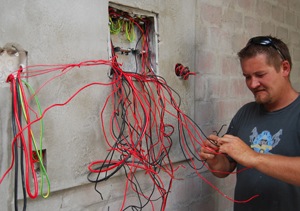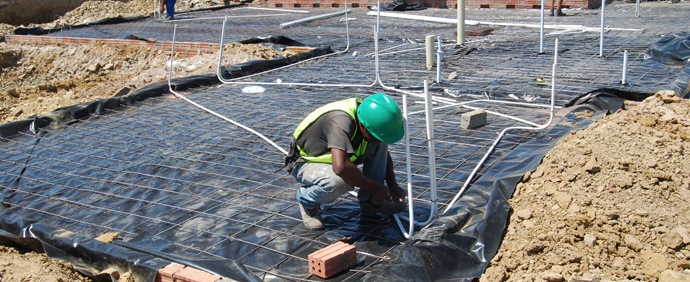Electric Cables – What is Legal
We get a lot of questions about which electric cables are legal and how they must be installed. So here is a brief rundown of the different types of legal cabling available and the way an installation could be done. There are various accepted methods and we illustrate a general one here. When a builder has to wire a home, he will first lay conduits, which are plastic or metal pipes fixed in place above the plastic damp-proof underlay and the steel reinforcing. (See the picture above.)
These pipes are layed out according to the house plans and extend upwards from the floor, and will be built into the walls later when the bricklayers start their work. The concrete for the floors will then be placed, and the conduiting will run within the floor slab. From there they can be chased, or cut, into the walls so that they can be routed to various outlet points where plug points and lights are required. The electrician will later pull the wires through these tubes. There are classes of cable that do not need to be encased in conduit and can be chased into, and laid directly under the plaster. Two examples of these are Surfix and Flat-Twin-and-Earth cables. A full specification can be found in the Aberdare brochure below. When the roof is on and waterproof the cables can also be layed in the roof space for overhead lighting and other fittings.

Be Guided by What the Law Says about Electricicty and Electric Cables
By law a fully qualified and registered electrician must be responsible for the wiring. It is a good idea for all homeowners to familiarise themselves with, and be able to identify, different types of cable and flex to ensure that all materials used in the installation are up to standard (literally – they need to meet the relevant South African National Standard).The National Building Regulations and Building Standards Act does not cover electricity and nor does SANS 10400. Electricians must comply with SANS 10142: The Wiring of Premises.
Depending on the class of cable the non-conductive insulation material around the wires inside cables and flex are different colours to make it easy to identify them. Green, or green and yellow, is the earth; live wires are brown or red; and neutral is either light blue or black. Once the wiring in a building is complete the entire system must be checked by an accredited person (from Eskom or the municipality/ local authority) who will issue a certificate of compliance.
Aberdare Cables have an excellent brochure (see below) that should help to identify the various cables associated with the electrical installation in a house.
[gview file=”http://sans10400.co.za/wp-content/uploads/2013/04/AberdareHouseWires_640.pdf” height=”900px” width=”680px” save=”1″]
[Note that we have no affiliation with this company and reference to their brochure does not imply any particular recommendation.]
 SANS10400-Building Regulations South Africa SANS10400 are the Building regulations in South Africa, and both international and national standards, are fundamental to successful building and construction projects, both big and small.
SANS10400-Building Regulations South Africa SANS10400 are the Building regulations in South Africa, and both international and national standards, are fundamental to successful building and construction projects, both big and small.


can you lay 2.5 flat surfix direct in the ground to supply a led pool light
Hi Jan, I guess that you mean the “Flat Twin & Earth” cable. This is widely used under plaster internally nowadays but I doubt if it is ok for external underground use. The normal surfix cable must be run inside conduiting. I suggest you contact either Aberdare Cables— +27 11 396 8000 or the ECASA— 011 392 0000 They will have the specs you are looking for.
How do i connect the surge protector on to a single phase DB connected box?
Moloto you don’t. You get an electrician to do it for you. Furthermore that person must be qualified and registered.
Subject:
electricity
Message:
Hi i bought a duplex home in a complexs. My garage is freestanding from my home. I have noticed that the power supply for the garage does not come from my DB inside the house. The power for the garage come
from a central point in the complexs. But the supply for the garage is supplying another 3 garages. Is this installation legal?
Hi Francois, This sounds as though the HOA is paying for the lighting in the garages. This could be a security consideration. This cost will then be shared by all the home owners in the complex through the estates/complex fees/rates and will be quite legal. I suggest that you have a look at your deed of sale. If you do not find anything then you can query this at the next HOA meeting.
I m n electrician but I have no certificate to prove that i m qualified and i would like to have it but i dont have cash to go to college, how can i get it?
You have to be registered to be able to call yourself an electrician. Contact the ecasa Electrical Contractors Ass. They do training and will give you advice.
Hi, I’m in the process of extending my home. This includes the kitchen. Placing electrical outlets (plugs) is my biggest concern. I need to add a number of outlets to the kitchen. Must all outlet points be routed from the floor or can they be extended from the ceiling in the walls (as with lighting) to the wall sockets?
First of all you need approved plans; secondly only a qualified and registered electrician can do the electrics.
Hi i am a gualified electrician but not registered and i want to wire a house ,what is yo advice dere coz i want mone to get registerd
Well you can’t do the work unless you are registered … so get a job with a registered electrician, save up, and get registered.
You dont need to be registered to wire a house but you would need a registered electrician to do the coc on the house that you have wired.
You have not answered his question
I have a house with a 3 phase supply. I’d like to know whether it is legal, when wiring plug points, to have more than one phase per room, e.g. can I distribute my appliance load in my kitchen across all three phases?
What are the rules regarding extending a 15 amp socket without chasing the wall. (Surface wiring). Eg.. how does electrician couple in to the existing socket?
Hi.
Thanks for a well presented site.
I am busy writing a textbook for school learners in the field Electrical Technology.
My I use some of the photo’s on your site, it is very clear and show exactly some fundamentals that we look at.
Regards
C.Marais
Thanks for the compliment, but if you want to use our pix there will be a fee. Let us know what it is that you want to use.
Philo electrics are not covered by the National Building Regulations. You need to contact a registered electrician for advice.
The National Building Regulations do not include electric regs so I really can’t help you.
Yes… that is why you have three phases!
What are the compliancestors regulations regarding black wiring and white wiring running outside the house?
Dear Robert
is it illegal to use a earth incorporated in the cable or must it always have a separate earth(bare)
Hi, I want to find out something. There is a business in town that needs some electrical repairs on lights came plugs. The plugs are external wall plugs. There is however a problem. The roof leaks and the walls have got water damage and the plaster is busy falling off. The owner doesn’t want to fix the roof or the walls but insist to just fix the electrical problems. Is there a law that regulates repairs as this?
Daniel the NBR govern new construction work and not maintenance. If you are leasing the property, what does the agreement say about maintenance? The norm would be that the owner is liable to fix this kind of damage.
I don’t know what you are talking about. What are “compliancestors regulations”? and what sort of wiring?
Hullo,
what is the minimum distance from a power line that a house can be constructed?
I am busy converting my garage into a flat. What I like to know is what cable do I have to use to be used to connect the power from the main house to the flat? I running the cable underground and I want to know if I use a 4 mm thick. White insulated 3 core cable if it’s going to be thick enough. Is there a certain type of cable I have to use
Hello, what are the legal requirements when it comes to how far copper Waterpipes should be layed from electrical sockets and or TV outputs. Thanks, TK
A registered plumber will know the answer to this question – and only a qualified, registered plumber should do the work.
This is not specified in the Building Regs
Only a qualified, registered electrician can do this work! If you do it the connection will be illegal.
no, check youe SABS i my years it was a max of 1,5 meter, a plumber wil not know this, but and electrician, it have changed in the years as you can have a cupboard dividing the exact length, and also some water appliances require you a connection within 30 cm from the the unit,
no, you must do a proper load flow, staring from the flat, make sure what exact load are reuired, and do a load flow from there, also a armor cable must be used, check your volt drop and amps regarding buried in soil, air, or ducted system, then check your feeder cable and ensure that it can handle the load together with the breaker
SABS is the answer, it is legal, as long as you get the result requested
it is not legal, each addition should have a new feeder cable installed as the existing feeder cables are be
designed for a specific load, and should not be used for an extension, of any sort.
no you must have some sort of protection, warning tape etc, best is to place it in conduit, be sure to check your load